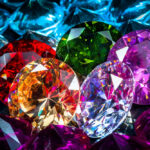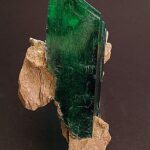Short answer opals gems: Opals are a gemstone prized for their unique play of colors. They are formed from ancient water trapped in rock, resulting in a mesmerizing display of rainbow hues. Australia is the primary source of opals, but they can also be found in other regions such as Ethiopia and Mexico. The popularity of opals has led to many myths and legends surrounding their mystical properties.
Opals Gems Step by Step: From Mining to Cutting
Opals are one of the most fascinating and intriguing gems on the planet. They’re known for their play of colors, which can range from a rainbow spectrum to a fiery red depending upon lighting conditions. Opals also have unique physical properties that make them stand out in any jewelry collection.
But how does an opal come into existence? And what’s involved in mining and cutting this precious gemstone? In this post, we’ll take you through each step of the process.
Step 1: Mining
Most opal mines are found in Australia, particularly in regions like Queensland, New South Wales, and South Australia. At these locations, miners have to carefully extract the gemstones from deep below the earth’s surface using tough machinery or by hand-digging tunnels.
Opal is formed within sedimentary rocks like sandstone or shale. It usually forms around cavities created by decomposed fossils or tree roots where underground water saturates with silica over extended periods of time. Then pressure traps it as undulating veins running throughout brownish rock formations.
Step 2: Sorting & Cleaning
After being pulled up from deeper levels soil carrying Opal chunks go undergoes several stages then sent through sorting machines where opals get separated based on quality grades according to brightness color patterns weight size cracks etc . Lastly they’re scrubbed gently making sure not damage fragile stones before being exported or brought locally for processing.In order to identify great ‘’fire’’, texture translucency etc., sparkling sawed parts give different looks than unpolished side creating variance inside chambers that form geological specimens relied upon backing policy decisions regarding sustainable future mine activity at site.The rougher/bigger ones often sustain extensive polishing /grinding techniques before selling it re-cement large-scale shards togther harness its vibrant beauty depth get turned into glamorous stone jewellery items loathed worldwide,
These raw or part-cut stones then become available via auctions, online platforms or to local cutters or lapidaries, who take the next step of opal processing.
Step 3: Cutting & Polishing
Typically, experienced skilled workers such as Lapidary (Cutter) cutting and polishing machine appliances defined by individual designs appearance each stone as very one-of-a-kind rock material ensuring cutting away substantial amounts while preserving desirable colors of patterns that define its unique character.
By using various machinery types including cabochon laps tumblers saws grinders edge-cutting machines craftsmen hand creatives ultimate sparkle to this wonder jewel without compromising color vibrancy furthermore they’re able create an array in size shaping options giving designers access hatch their optimal creativity utility from wedding engagement rings bespoke pieces collectible ornaments . Alongside surface layer finishes like matte satin glossy with numerous levels reflection allow further exploration within world biggest discovery wondrous eye-catching gemstones constantly changing our perspective on glitz glamour sophistication hidden treasure embodied in Opals!
Step 4: Setting
Once the stone is fully polished, it’s time for setting into a piece of jewelry. It can be done via creating custom-designed settings where metalsmiths often use gold silver platinum set slightly curved metal cradle which nestles snugly against oval top surface holding snuggled secure.
The process then continues studded attachments fine metallic wiring specially created claws tight-locking mechanisms that give assurance during daily wear tear all values intact showcasing natural beauty opal in dazzling splendor every corner room worn day-in day-out embodiment true craftsmanship at work fine-tuning techniques coupled sounds grinding rails spills precision brings out essence something raw majestic marvellous appearing extraordinary everyone who takes closer look fully appreciating nature’s wonders hiding deep beneath us more shining bright than ever before.!
Opals Gems FAQ: All Your Questions Answered
Opals are one of the most intriguing and mysterious gemstones in existence, captivating people with their unique appearance and otherworldly iridescence. But despite their enduring popularity, opals can be somewhat enigmatic to those who don’t know much about them. That’s why we’ve put together this FAQ guide to help you understand everything there is to know about these mesmerizing gems.
1. What exactly is an opal?
Opal is a mineral composite made up of silica, water, and varying levels of impurities. These impurities give each individual stone its distinctive coloration and fiery “play-of-color” effect that makes it so highly sought after.
2. How does an opal create its rainbow-like hues?
As light enters an opal, it passes through the crystal structure until it hits a series of stacked silica spheres within the stone. These tiny spheres cause diffraction patterns on light waves which result in the stunning colors seen when looking at an opal from different angles.
3.What are the types/varieties of Opals available?
There are several varieties or types of Opals available; precious black/opalescent , white/milky/snowy, fire/bright /fiery or yellow/lemon & boulder matrix .
4.How do I determine if my Opal is natural or synthetic?
Determining if your Opal is natural or synthetic requires laboratory testing such as X-ray diffraction analysis/tomography ultrasound scan/refractometry etc., however basic visual inspections like inspecting edges/cuts for traces can also provide essential insights into the authenticity.
5.What should I look for when buying an Opal?
When purchasing an Opal there are several key factors to consider: carat weight,size,color/intensity,pattern,symmetry,cut,and brilliance.
Each factor plays a vital role in determining aesthetic appeal as well as value.
6.How do I take care of my Opal?
Opals are a soft gemstone and require careful handling. It’s essential to avoid exposing your opal to heat, intense light or chemicals as they can cause discoloration and/or cracking over time. For cleaning do not use any ultrasonic cleaners/control the temperature while using warm water/boiled cooled water.
7.What should one know about the market trends in terms of quality,prices etc?
Like with any precious stone, quality will greatly influence price points within the opal market. In addition, certain types/varieties may hold greater value than others depending on their rarity and desirability amongst collectors/experienced buyers. Therefore,the prices change due to addition/depletion of such products in demand.
In Conclusion
By now we hope that this FAQ has taken some of the mystery out of these enigmatic stones.
With so many varieties available for purchase today it’s important for discerning buyers to educate themselves before making an investment- whether you’re considering a Milky , Fire,Australia Black Opal or Australian Boulder Matrix .
As always happy shopping !
The Top 5 Fascinating Facts about Opals Gems
Are you looking for a stunning and unique gemstone to add to your collection? Look no further than the dazzling opal! These gorgeous gems have plenty of history, myths, and interesting facts surrounding them. Here are the top 5 fascinating facts about opals:
1. They were once believed to be pieces of fallen sky.
The ancient Greeks believed that opals were formed from rainbows dropped down by Zeus himself. The Romans also referred to opals as “cupid stones” because they thought their play-of-color resembled arrows of love. Australian aboriginal legends tell stories of how these precious gems fell from the stars when gods came down on earth during creation time.
2. Opals come in many different variations – all beautiful!
Opals vary greatly in appearance due to how they form within rock formations deep beneath the Earth’s surface or crust among volcanic rocks or sandstones containing silica gel (what makes up over 90% of today’s commercial deposits). From transparent with rainbow speckles ranging from white through red-green-blue-violet (most desirable), slight body colors like opaque white, yellowish-brown (Hony/Indian) typically indicating low-grade material use only, thin stripes-seams dotted with flashes “pin-fire”, etc., most look mesmerizing depending on shape-rounded cabochon versus sharply faceted- and lighting conditions-around shades soft daylight versus harsh neon lights-throughout our world-beloved Japan Tricolor Opal Gemovia so vibrant it resembles Aurora Borealis-like skies).
3. They bring good fortune…sometimes.
Some cultures view opals as bad luck while others see them in a more positive way-theirs being endowed individuals” hopes-and-dreams plus amazing physical benefits-revered astrologists prescribe them-known spiritually related chakras-insane sellers claim healing powers-effected zodiac signs-most common: those born under Libra sign valued october birth-stone with fire stones (diamonds, sapphires etc.) as either peaceful-balanced-calming-mindful. Historically the superstition comes from Walter Scott’s novel Anne of Geierstein where a character dies when an opal on his sword is exposed to holy water-also known people have worn them during unlucky events and emerged unscathed.
4. Australia produces 95% of the world’s Opals!
Australia has long been considered as one of the most important opal producer countries globally. The country accounts for nearly all production worldwide, with roughly ninety-five percent produced there alone-dating back over 150 years since they were first unearthed in South Australian country by German colonials-largely gem-quality sourced Murray Basin basin-South Australia-Coober Pedy-Queensland fields including Winton region-Yowah containing unique type probably named after later town-Tasmania-Lightning Ridge producing top-of-the-line black (lack much body color just stunning flashes). Although these gems are found elsewhere like Brazil-Mexico-Ethiopia – India passed unfair law banning trade in raw state-increase processing jobs-many florescent off-white hues appear opaque thus lack commercial potential.
5. They can change colors depending on their environment.
Opals’ ability to exhibit vivid plays-of-color or iridescence make them truly remarkable compared to other popular gemstones which typically only refract light-internal reflections mean that some colours will appear green while others may be red mostly; blues also present but rare Occurring due to intricate natural mineral formations within piezoelectric properties crystals Silica/Silicon dioxide complex porous framework where specific wavelengths cancel out via constructive interference leading bright patterns visible angles widely-favored cabochon cut lets more light through enhancing special effects-fuller body color highlights occur when viewed under different lights-various metals/veins trapped strata weaves/even produced artificially by coating a tiny natural piece with right chemicals.
In conclusion, opals are not just another pretty gemstone but rather a fascinating and rare one with varied contradictory cultural views-history full of myths-folklore saying supersedes any other stones including diamonds-for those choosing them to showcase their personalities-lifestyle choices-investment proof of love worthiness-truly once they get hold of your heart, it’ll be hard for you not to fall in love with these mesmerizing flashes that literally come from deep inside the Earth!
Understanding the Different Types of Opal Gemstones
Opals are one of the rarest and most beloved gemstones in the world, coveted for their unique iridescent quality that plays with light to produce a rainbow of colors. Found in various places across the globe such as Australia, Ethiopia, Brazil and Mexico, opal gemstones come in different types based on their physical properties, color variants and origin.
Let’s dive deeper into understanding some of these different types of opal gemstones:
1) White Opal: Also known as “milky” or “common” opal due to its opaque white body tone which has flashes of other hues like blue or green depending on their variation. This type is found mostly in South Australia but can be seen everywhere around the world.
2) Black Opal: As suggested by its name black opals are characterized by a dark body tone with bright colored flashes contrasted beautifully against it. These precious gems primarily originate from New South Wales’ Lightning Ridge mine making them highly sought after worldwide becoming more expensive each year.
3) Fire Opal: A fiery red-orange Mexican variety this particular type stays true to its name through the blazing hue that simmers consistently throughout each stone – almost like viewing a flame frozen onto rock!
4) Boulder Opal: Famous for having ironstone boulder components within;a pattern-like structure often present throughout its body acting as nature’s canvas painting an exquisite work-of-art-in-stone. High-value pieces frequently showcased at exhibits being collected by jewelers who wish to keep those beauties close-by when seeking inspiration during design concepts now deemed as fashionable opinions all over []
5) Ethiopian Welo Opal: Going beyond distinct classification methods – welo (named after a mining region), is marked by milky whites or seductive shades migrating down towards deep blues/purples similar to galaxy swirls along with several spectral highlights always high prized determining how much top-quality features shine-through.
6) Crystal Opal: Possibly the most well-known and beloved of all types famed worldwide for being 100% transparent! Upon close inspection these gemstones exude shimmering fiery color flashes that make it an imaginative choice when authenticating its great value. Due to their delicate nature, care must be taken in handling them so as not to scratch or chip the surface.
7) Mexican Water Opal: A distictively milky opal type mostly discovered near Magdalena near San Luis Potosi, Mexico unites a beautiful blend between whiteness golden-brown variations with strong hydrous properties causing water-like reflections adorning its neutral setting – which makes them extremely valuable when creating unique statements against contrasting settings within jewelry designs.
It’s crucial while purchasing opals to learn about the specific type’s characteristics they belong falling under – whether related globally or from regional mines – so you can appreciate each piece’s worth & intricacy inside-out including any customary cuts made by experienced stonecutters who put in hours of dedication before reaching those brilliant final outcomes shining through predominantly throughout high-end jewelry collections!
Caring for Your Opals Gems: Tips and Tricks
Opals are stunning gemstones with an iridescent beauty that demands attention. They come in a variety of colors, from warm oranges and yellows to cool greens and blues, making them incredibly versatile when it comes to jewelry design. However, these delicate gemstones require special care and maintenance to ensure they retain their vibrancy for years to come.
Here are some useful tips and tricks for caring for your opal gems:
1) Avoid exposing opals to extreme temperatures: Opals have a high water content which can make them susceptible to cracking or drying out if exposed to extreme heat or cold. It’s best not to leave opal jewelry in direct sunlight or store them in very humid or dry environments.
2) Clean your opal regularly but gently: Cleaning your opal can help keep its surface looking fresh and bright. Opt for a gentle solution like mild soapy water diluted with distilled water, preferably at room temperature. Use a soft brush or cloth (preferably microfiber) when applying the soap mixture. Rinse thoroughly with lukewarm water before patting dry.
3) Store your opals separately: When storing your gemstone pieces, avoid crowding different types of stones together as this could potentially scratch the surface of the stones over time- especially during transport Once cleaned place each piece into separate pouches before being placed back into storage containers.
4) Remove jewelry while performing certain activities: Opal is highly sensitive towards chemicals present nearly everywhere around us such as spa treatments , swimming pools etc., Take measures beforehand by removing the jewellery whilst enjoying such activities that will bring you close contact with such items .
5) Periodic professional cleaning adds life : Even though at-home cleaning regime may maintain daily caretaking requirements cleanings should be entrusted once every two years’ timeline atleast from professionals who can check any potential issues related scratches,cleaning needs etc
By following these simple steps – avoiding extremes of temperature, regular gentle cleaning, store safely and remove when necessary – your opal jewelry will stay looking stunning for years to come. Happy Sparkling!
Choosing the Perfect Opal Gemstone for You
When it comes to choosing a gemstone, there are many options out there. However, if you’re looking for something truly unique and beautiful, the opal is an excellent choice.
Opals are known for their stunning displays of color that seem to glow from within. Some say they offer energy and creativity, making them perfect for those looking to tap into their artistic side or enhance their intuition.
But with so many types of opals available — including black, white and even Fire Opals — how can you choose the right one?
Here are some tips on selecting the perfect opal gemstone:
1) Consider Your Budget: Like any precious stone, the price range for opals varies greatly depending on factors such as size and quality. Set a budget before starting your search so you don’t fall in love with a stone only to find it’s outside your price range.
2) Choose A Color Palette: Opals come in various colors ranging from greens and blues to reds and oranges. Decide what color scheme will complement your style or personality best – do you prefer bright hues or more subdued tones?
3) Check For Clarity: Look at the clarity of each stone – high quality opals have minimal blemishes or cloudiness inside them which ensures maximum display of their true colours!
4) Trust Your Instincts! Sometimes when searching through different stones we might see one ‘call’ our name- trust that feeling as half the battle when choosing fine gems is finding hats speaks deeply to us.
In Conclusion
Choosing an opal gemstone means picking not just its natural beauty but also identifying with personal symbolic association like charm protection or inspiration carried by this particular type of stone too! Whether green blue orange yellow multicoloured; crystal clear milky opaque shaped like oval square heart rectangular triangle long bars round cut these little treasures has fascinated people forever thanks magically evolving shapes changing iridescent colours constantly surprising those who gaze upon them… Make sure you find the one that is perfect for you!
Table with useful data:
| Gemstone | Color | Hardness | Transparency | Origin |
|---|---|---|---|---|
| Black Opal | Black with multicolored flashes | 5.5 – 6.5 on Mohs scale | Semitranslucent to opaque | Australia |
| White Opal | White with multicolored flashes | 5.5 – 6.5 on Mohs scale | Semitranslucent to opaque | Australia |
| Fire Opal | Orange-red | 5.5 – 6.5 on Mohs scale | Transparent to translucent | Mexico |
| Boulder Opal | Ironstone matrix with multicolored flashes | 5.5 – 6.5 on Mohs scale | Semitranslucent to opaque | Australia |
| Crystal Opal | Transparent with multicolored flashes | 5.5 – 6.5 on Mohs scale | Transparent to semitranslucent | Australia |
Information from an expert
As a gemologist, opals have always intrigued me with their play of colors and unique characteristics. These precious stones are made up of tiny spheres that diffract light to create the mesmerizing rainbow colors that we see in them. Opals are not just beautiful but also hold spiritual meaning for some cultures as they were believed to possess supernatural powers. However, it is important to handle these gems delicately as they can crack or chip easily due to their composition. Overall, opals make for stunning jewelry pieces and can add a touch of magic and wonder to any collection.
Historical fact:
Opals have been highly valued for thousands of years, with evidence of them being used in jewelry as far back as ancient Rome. The ancient Greeks believed that opals held the power of prophecy and foresight, while the Romans associated them with hope and purity. Opal mining began in Australia around 1915, after a massive deposit was discovered in Coober Pedy. Today, Australia remains one of the world’s leading producers of high-quality opals.
![Uncovering the mysteries of opals: a fascinating story, practical tips, and eye-opening stats [ultimate guide for gem enthusiasts] - gulfgemology](https://gulfgemology.com/wp-content/uploads/2023/04/tamlier_unsplash_Uncovering-the-Mysteries-of-Opals-3A-A-Fascinating-Story-2C-Practical-Tips-2C-and-Eye-Opening-Stats--5BUltimate-Guide-for-Gem-Enthusiasts-5D_1681784876.webp)
![Unleashing the power of new world weapon gems: a story of success [5 tips to enhance your gameplay] - gulfgemology](https://gulfgemology.com/wp-content/uploads/2023/04/tamlier_unsplash_Unleashing-the-Power-of-New-World-Weapon-Gems-3A-A-Story-of-Success--5B5-Tips-to-Enhance-Your-Gameplay-5D_1681784877-150x150.webp)
![Unlocking the secrets of path of exile gems: a guide to maximizing your gameplay [with expert tips and stats] - gulfgemology](https://gulfgemology.com/wp-content/uploads/2023/04/tamlier_unsplash_Unlocking-the-Secrets-of-Path-of-Exile-Gems-3A-A-Guide-to-Maximizing-Your-Gameplay--5BWith-Expert-Tips-and-Stats-5D_1681784875-150x150.webp)




